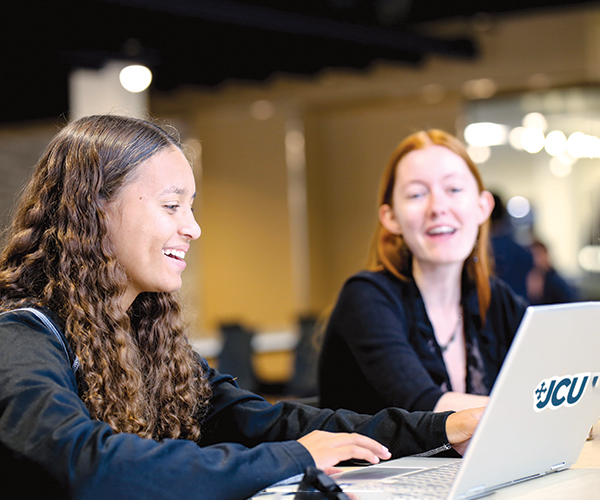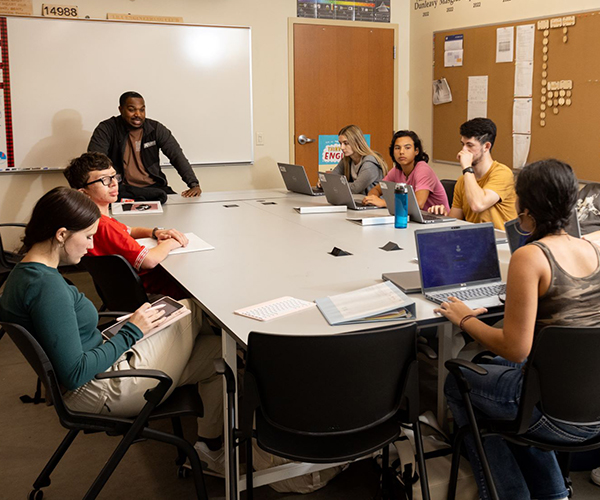Guide To Education: Social Status
by Heide Aungst | Feb. 24, 2014 | 5:00 AM
Four girls sit with their desks facing each other in the middle of Alison Morgan's honors Spanish III class. The rest of their St. Joseph Academy classmates form a semicircle around them, watching as they quietly work together on a class presentation.
In fact, they're a little too quiet for the surrounding observers. "Por que Jen est la sola persona que esta hablando?" (Why is Jen the only person talking?), appears on an interactive whiteboard in front of the class.
The technology, from TodaysMeet, allows participants to hold a real-time conversation on an activity or lecture occurring simultaneously. (It's like Twitter, but private and without the need to know people's handles or the correct hashtag.)
"Zzzzzzz," flashes across the board next.
A few girls giggle. In any language that means I'm falling asleep here, totally bored.
Morgan reminds the presenters to talk in Spanish as they collaborate and speak for all to hear. The goal of the exercise is for the four girls to converse in Spanish while the others listen, evaluate their work and comment in Spanish so everyone can see and respond. It's a fun way to practice language listening and writing skills. Fun, that is, when there's an active conversation going on in the center to observe.
Ryan MacRaild, St. Joseph Academy's instructional technology educator, clicks a few buttons on his computer and soon everyone in the room can view the group's presentation on their personal Chromebook laptops. So in addition to commenting, the girls can watch the PowerPoint come together even when the group isn't discussing much.
And, while doing all that, some girls also are using Google Chat to instant message each other — kind of like passing notes in the old days.
MacRaild uses his smartphone to snap a picture of the classroom's fishbowl setup and tweets it out. Within seconds, the picture is favorited by Jeremy Shorr, the director of educational technology and curricular innovation for Mentor schools, a county over from St. Joseph's campus in Cleveland's West Park neighborhood.
This is the image of today's interactive, connected classroom with students using multiple forms of technology simultaneously to stay engaged in their learning.
In fact, 41 percent of higher education teachers surveyed by Pearsons Learning Solutions say they used social media in their classrooms last year, a 7 percent increase from 2012.
That's good news to Jeremy Brueck, associate director of the Center for Literacy at the University of Akron. He has seen innovative teachers from kindergarten through college use social media to engage students.
"If we really took a critical look at social media in the classroom, there would be countless stories of how it could be used to enable or enhance teaching and learning," Brueck says.
A kindergarten teacher, for example, might tweet about a snowstorm in Cleveland and ask, "What's the weather like there?" Her students can map responses and learn about geography, seasons and the science of weather — all by connecting to others outside the four walls of the classroom.
Fifty-nine percent of higher education faculty believes the interactive nature of online and mobile technology creates a better learning environment, according to the Pearsons survey. And whether through blogs, Facebook, Twitter, Instagram or Pinterest, teachers are discovering how social media can improve engagement.
"What social media has opened up for students is a two-way dialogue between the poster and the consumer of that particular media," Brueck says. "If it's used in an educational setting, that can be extremely powerful."
• • • • •
Holden Caulfield would likely deem Mike Strauss' assignment for his sophomore honors English class "phony." But, then again, the narrator and main character in J. D. Salinger's classic The Catcher in the Rye had strong opinions about a lot of things.
It's one reason Strauss, English department chair at St. Ignatius High School, asks his students to tweet as the character. Since many teens identify with Caulfield, the social media assignment helps students summarize plot points and grapple with the book's themes of identity, isolation and shifting cultural attitudes through Caulfield's point of view.
"If I told the kids to go home and write summaries after each chapter, they would moan and groan and shut down," Strauss explains. "But if I say, 'Hey, we're going to tweet,' they get a lot more excited."
So in addition to regular assignments, quizzes and tests, Strauss created a Twitter account for the class and had students set up accounts separate from their personal ones so he wouldn't have to weed through weekend plans to find their homework. He also gave the option to complete the assignment in a Word document out of respect for families who don't permit social media.
Using Twitter allowed the class to follow each other, and Strauss says his students were great at getting their points across and expressing Caulfield's voice, while showing they had read the chapter.
"It's using this technology that's really a part of them," he says.
There's an additional benefit as well, Strauss notes, one that counters critics who claim texting and social media are creating a generation that doesn't appreciate writing and reading.
Twitter's 140-character limit forces students to choose their words carefully, he argues. Learning to write the Twitter way actually pairs well with William Zinsser's chapter on simplicity in On Writing Well, published more than 35 years ago — long before social media.
It's a great bridge to the traditional essay or research paper, which he also requires.
"The idea is to get rid of the fluff, get rid of the extravagance, so the kids can say something in a simple way," Strauss says.
"The most exciting thing about social media is that young people are writing a lot," adds Molly Buckley Marudas, assistant professor of English education at Cleveland State University.
For her doctoral dissertation, Buckley Marudas spent two years in a Philadelphia high school following 122 teenagers to see how they used new technologies and understand the nature of literacy learning in an environment that didn't limit the use of iPods, iPads, cellphones or laptops.
"A lot of people are worrying that it's not real writing," she says. "But my hope would be that we could shift and say it's actually expanding kids' repertoires of writing."
That's certainly the case for Jon Smith, technology resource teacher at Alliance High School. When he taught special education to fifth- and sixth-graders in the Canton schools, he motivated his class by having students work together to write and publish e-books using Apple's iBook. One advantage, he says, was that they could embed their own drawings, photos or videos to complement the text.
When it was complete, the book was available for download from the Apple Store.
"They'd learn that people all over the world were downloading our books," says Smith, who also got a math lesson out of the project by having students graph the number of downloads. "It made writing more valuable to them."
• • • • •
At St. Joseph Academy, the evolving educational landscape has prompted changes in the all-girls school as well.
To support multiple devices used each day, the school increased its Internet bandwidth throughout the campus. This year, all 690 students received a laptop as a part their tuition. Every girl also has her own profile page on Schoology, a private learning management system that resembles Facebook where students can track assignments and connect with each other and faculty.
To distribute the new computers, the school held a boot camp with parents and students to teach responsible computer usage and some behind-the-scenes social media facts. For example, every time you tweet, it sends out your location, but that feature can — and MacRaild says, in the case of students, should — be turned off.
"There's issues associated with the responsibility that comes with social media," says MacRaild. "So it's important to educate them."
Many teachers, including 63 percent of higher education teachers surveyed by Pearsons, have reservations about student privacy when using social media in the classroom. So educators are using it as a teachable moment for their students.
"I'd rather see the kids slip and fall here so we pick them back up," says MacRaild. "If something happens outside of school, we may not be able to get to them and give them that assistance."
Sally Garza, technology director at Lawrence School's Upper School in Sagamore Hills, points out to her students that the Library of Congress has started archiving all tweets — 400 million each day. So when someone says that what you say in social media lasts forever, it is true.
And what you say in middle school can impact your ability to go to college or get a job.
Such a concept can be difficult for a teen to grasp. Consider your own middle school days and some of the things you said or did, Garza tells parents.
Even little problems or teasing gets exacerbated when it is available for the whole world to see.
"We're assuming, as adults, that the kids will naturally pick up not only how to use the services, but how to make appropriate decisions," Garza says. "That's not always true. They don't always have the ethical boundaries of making good decisions, of how we interact and communicate as human beings."
Ultimately there are consequences to not using social media in the classroom, as well.
"Social media is not going away," says Alliance High School's Smith. "So if we don't model for them what good social media interactions are like, then where are they going to get that from?"
• • • • •
By its very nature, social media can be a powerful tool for educators to help encourage community and dialogue.
At Hathaway Brown School in Shaker Heights, for instance, an Instagram project united the entire school, from kindergarten through high school seniors, in a way that had not happened before, says Koyen Parikh Shah, director of the Center for Leadership & Well-Being.
Throughout the school, students were exploring the importance of educating girls. The older girls had watched the documentary Girl Rising, about harnessing the power of education to change societies, while the younger girls read picture books such as Beatrice's Goat, a story based on the life of Beatrice Biira, an impoverished Ugandan girl.
Then they came together in age-diverse groups with an iPad and the theme "Girls and Education." Each group of between 15 and 20 students was given about 30 minutes to write and create a 15-second video on Instagram. Later, the short pieces were joined into a longer video that went out to parents, board members and alumni on the International Day of the Girl in October.
"A shared learning experience is really powerful, and Instagram was the mechanism by which we were able to connect the learning over a huge number of people," says Shah. "The end result was people felt it was energizing. People felt unified. People felt connected to the material and to one another because of the project."
The goal is similar for students in the entrepreneurial studies class at Hawken School's University Circle campus.
There, students take turns each week as social media manager and learn to use social media to benefit business. But they also learn deeper lessons about human relationships in the process, says Natasha Chornesky, former director of Hawken's Entrepreneurial Program.
"Social media has turned out to be a great way to coach kids on empathy and acquiring empathy," Chornesky says. "It's not enough to just push a message out there on a platform. If you're really doing social media well, you're building a relationship with your customer."
That requires a much higher level of understanding about the audience, and their wants and needs. "You really have to understand who that customer is and what your customer is doing," Chornesky adds.
Last semester, students created an advertising campaign on Pinterest for Mr. Beams, an LED lighting company based in Solon. The students came up with the theme "Eat Light" and created playful images featuring lights in a mouth and lights between two halves of a hamburger bun.
"For teenagers to come out of their own head and really be in situations where they have to think about other people, that makes them better, stronger more sympathetic human beings," says Chornesky. "Social media is truly about being human."
But being human also means having downtime, away from technology.
Cleveland State's Buckley Marudas encourages families and schools to have digital- and device-free zones. "In schools, we can help young people develop their strategies for finding some time and space to shut down or unplug from all of the possible stimuli and connections, and be present with the people in their company," she says.
At St. Ignatius, Strauss' students get that message when they study Walden by Henry David Thoreau.
Strauss asks them to look at ways to simplify their lives, by choosing something to get rid of for a week and keep a journal about it.
"A lot of kids chose to give up Twitter or Facebook," Strauss says. "They saw how much that impacted their lives, often in negative ways, just by the way it consumed so much of their time."
Strauss also requires students to spend a half-hour — about every two weeks during the entire academic year — sitting quietly in the same spot in nature, and writing about it.
"It's a nice time for them to unplug and get away from the stresses of school, the stresses of technology and to actually have some quiet time," he says. "They're always entertained, and their minds are always racing, and they don't have the time to just slow down and be in thought. It's a powerful lesson."
School Choice
Picking a college isn't easy. Here are some tips for finding the right campus for you.
Lillie Hall began looking at colleges in middle school, searching for just the right fit on the Internet. She wanted a midsize school highly regarded for its academics and offering a good band program. When she found a place that interested her, she'd dig in, researching it further, discussing it with her parents and sending away for more information.
The Cleveland Heights High School senior started informally visiting campuses as a freshman during travels with the marching band. Then during the summer before her junior year, she toured three campuses with her parents, including her dad's alma mater, Ohio University.
Lillie's No. 1 choice, though, was a small liberal arts college that appeared perfect ... until she and her mom, Margaret, visited: The admissions presentation seemed too scripted, the tour guide pitched her sorority more than the school and the dorms smelled really bad. The biggest shock for them was the lack of diversity on campus.
"We didn't even realize it was an issue that was important to us until it was put in our face," Margaret says.
After the tour, the mother and daughter pair stopped students walking on campus to ask straightforward questions about the school, including campus diversity. Caught off-guard, students answered honestly instead of giving a rote spiel from an admissions' presentation.
"Everybody says how racially balanced they are," Margaret says, "but nobody looks at what the students are really doing."
That's why college counseling experts recommend combining a formal campus tour with informal discussions with students before making any final decision.
"A student will spend the next four years of his or her life on the campus and thousands of dollars to attend," says Tracy Stockard, director of college counseling at Gilmour Academy in Gates Mills.
But with students applying to up to 10 colleges on average, the process can get pretty daunting and expensive. Here are some crib notes from area college counseling experts to help you along the way.
Know your college counselor. "Take the initiative to talk with your counselor throughout your high school career," says Jennifer Mattes, postsecondary guidance director at Lawrence School in Sagamore Hills. Guidance counselors report more than test scores and grades to prospective colleges. They also assess intangibles such as social interactions and motivation.
Do more than Google. Whitney Lloyd, director of college guidance at Montessori High School in Cleveland's University Circle, recommends two books to get a more objective view of prospective schools: Fiske Guide to Colleges by Edward Fiske, which is updated annually, and Colleges That Change Lives by Loren Pope, a look at smaller liberal arts schools.
Stray from the tour. "Look at the bulletin boards in the hallways," says Linda Gabor, director of college counseling at St. Ignatius High School. "What kinds of speakers do they have on campus and what kinds of activities are going on?" Pick up the college newspaper, too, to learn about campus life and other things that interest you.
Be a shadow. Without a major in mind, it's tough to evaluate a college. Shadowing a professional in your field can give insight into what the real world might look like. "If you love it, fantastic," says Lawrence's Mattes. "If you hate it, that's also fantastic because you know you don't want to major in it."
Use Northeast Ohio as a resource. Northeast Ohio has every type of school within a short radius, including urban campuses (Cleveland State University and the University of Akron), a large state university (Kent State University), a research university (Case Western Reserve University), small liberal arts schools (Baldwin Wallace University or John Carroll University) and even a rural environment (Lake Erie College). Discovering the atmosphere where you're most comfortable can be important even before looking at specific schools, says Andrea Hays, director of college counseling at Hawken School in Gates Mills.
Don't share everything. Talking about the admission process can build competitive pressure. "Once you put it out there, it leaves it open for people to question," Hays says. Talk should be limited, even within the family. "I highly suggest designating one night during the week, preferably over a pizza dinner, when the family agrees to discuss the college process," Gilmour's Stockard says. "Students don't feel like every day they are being bombarded with questions about college, but parents know they can get at least a solid half-hour when the entire conversation is on an important topic."
Take the blinders off. Let go of the notion that there's a perfect school for you. "There are so many ways to be happy in college," says Terry McCue, assistant head of school and director of college counseling at Hathaway Brown School in Shaker Heights. That includes pining for the Ivy League, where some schools admit fewer than 10 percent of applicants. "When people start to feel like, This is my soul mate college and if I don't go there, I'm not going to have a great college experience, the stakes start to feel very high emotionally," she adds.
Understand how financial aid works. While experts say it's important to be honest about how much you can afford or are willing to sign for, it's even more important to understand that making a decision based on an online number isn't a good idea. "Sometimes you see families simply looking at how much a college costs and saying, 'That's too much for us, so let's not pursue this option,' " McCue says. The key is what percentage of need a college is likely to meet. Frequently, students pay less to attend a private school that costs $60,000 a year than they might a state school that costs $20,000 a year. To determine need, use the financial aid net price calculator that is now available on every college's website. In addition, bigfuture.collegeboard.org provides the percentage of need a college is likely to pay.
For her part, Lillie Hall learned quickly how to ask the right questions on a campus tour to discern who was being genuine. Her favorite questions became, "How did you do in high school?" and, "How did that change from high school to college?"
She fell in love with Bethany College in West Virginia, where her grandparents and great-grandparents met.
In September, she got her early admission acceptance letter, and recently went to a sleepover with the swim team, forming connections even before getting to campus. And now, she says, they are Facebook friends and follow each other on social media.
But that leads to one last piece of advice from experts. The college application process can be grueling, but don't be tempted to go nuts after getting in somewhere.
"I have seen schools rescinding offers of admission when they find students using social media to share their bad behaviors with the world," says Gilmour's Stockard. "This is not a rumor. ... I have seen this firsthand. It is quite scary to think that four years of hard work can go down the drain with a click of a mouse."
Write Turns
Ah, the dreaded admissions essay, a task as treacherous as hunting a white whale. But it doesn't have to be. The college essay can also be a great opportunity to step up and capture your call-me-Ishmael moment.
"At this age, students all want to fit in and look like everyone else," says Linda Gabor, director of college counseling at St. Ignatius High School. "We encourage them to look a little deeper and to provide some insight that the college wouldn't get by just looking at their transcript or test scores."
So, like Herman Melville in Moby Dick, start strong, advises Tracy Stockard, director of college counseling at Gilmour Academy in Gates Mills. "Always make sure the first sentence grabs your reader and keeps his or her attention," she adds. "If your essay is dull from the start, what is going to convince the reader to keep going?"
Most colleges will ask,"Why this school?" Use your own voice when answering, the experts caution students. "If you're writing something that you could literally pick up from the admissions flyer or go to the website — if you're saying anything they say in their standard marketing materials — that's not a good enough answer," says Andrea Hays, director of college counseling at Hawken School in Gates Mills.
It's important to assess the personal reason for applying to a school. "The reason they ask that question is so that students take time to research the school further than what admissions has on that page," says Laura Walsh, director of college counseling at Andrews Osborne Academy in Willoughby.
And while it's OK to get essay advice from an English teacher or college counselor, the experts suggest that parents not get involved.
"When I speak to parents, I make it clear that they should absolutely never, ever write their students' essays or fill out any part of the applications," says Walsh. "The college admissions offices are really smart, and they can tell when the student's not writing it, and they'll hold it against them."
Trending
-
1
-
2
-
3
-
4
-
5










